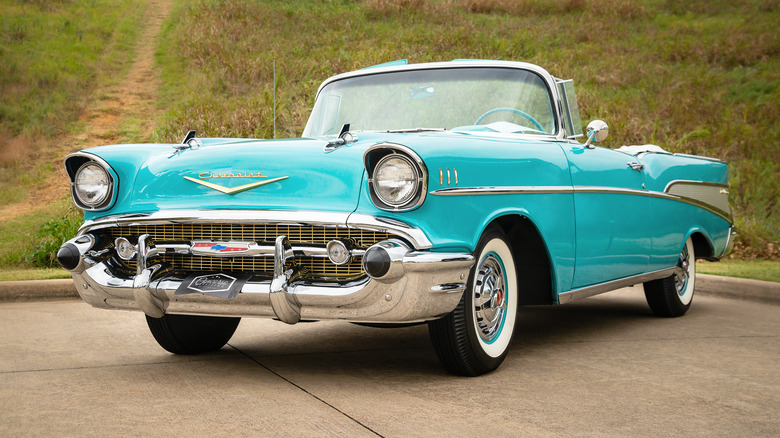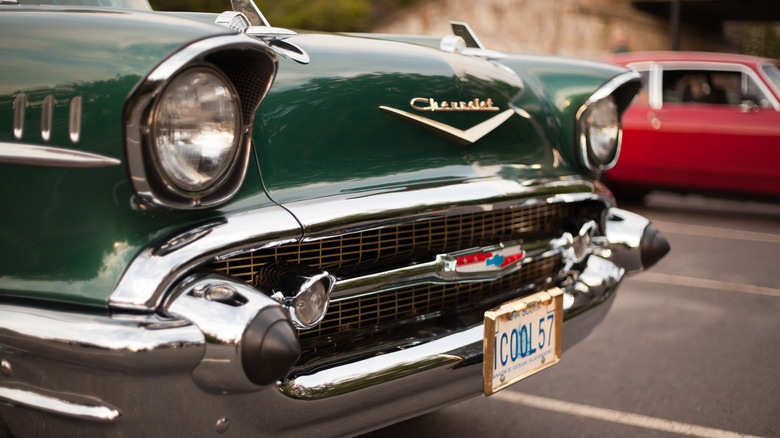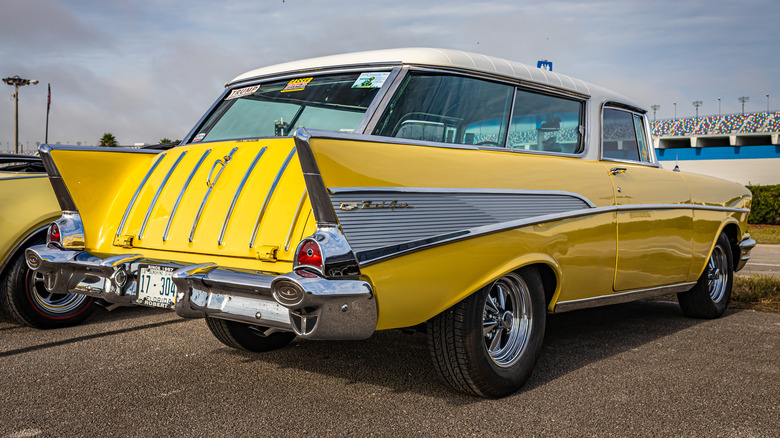Everything To Know About The 1957 Chevrolet Bel Air
When it comes to icons of the American automotive history, you have the Model T, the Mustang, the Corvette, the Continental, and the F-150, among many others. There is a good chance that many people would also include on that list the 1957 Chevrolet Bel Air, which was the crown jewel at the end of the automaker's Tri-Five era that began in 1955. With a Dagmar bumper, headlights that look like eyes under brows, and those extended tail fins that began with the 1957 model, it is in many ways the quintessential design of a 1950s American car at its most stylish and luxurious. To this day, you can find them being sold in various conditions for around $30,000 to prices north of $150,000.
As to why the 1957 Bel Air became such an automotive icon, you could boil it all down to the vehicle's aesthetic appeal. Cars today simply do not look like this anymore, and the nostalgia mixed with the luxurious sleekness makes it an enticing prospect for those interested in vintage automobiles. However, there is a lot more to the Bel Air than its looks. So, let's take a look at what made the Bel Air so special back in its day, and how it has maintained its reputation in the decades since.
The 1957 Chevrolet Bel Air offers a mix of luxury and performance
The Bel Air name given to these cars back in 1957 designated more of a trim or package for the vehicle. The 1957 Chevrolet was offered in three different iterations: the 150, the 210, and the Bel Air, each giving you features, amenities, and designs specific to that particular package. Every subsequent package saw upgrades in aesthetic features and more premium interiors, with the Bel Air acting as the top level version of this particular model.
Although the look of the Bel Air is quite iconic, there was no one-size-fits-all version of the vehicle. Buyers had the option between a two-door coupe or a four-door sedan, both of which were available as a convertible or with a hardtop. Underneath the hood, the car came standard with Corvette's 235 CID Blue Flame I6 engine, which was able to generate 140 hp and 215 pound-feet of torque. However, those who desired to have some more power could opt to get a 283 CID V8 engine — a small block engine that packs more of a punch than you'd expect — which was fitted with Rochester-made fuel injection that upped its output to 283 hp and 290 pound-feet of torque. The Bel Air wasn't just a luxury Chevrolet package; it was also quite the performance vehicle.
The Bel Air also came as a station wagon under different names
The primary way that someone would get a 1957 Bel Air would be as a coupe or sedan, but the Bel Air was also available as a trim for Chevy station wagons like the Nomad at the time. This larger vehicle was introduced at the beginning of the Tri-Five era and came equipped with everything available in the standard-size Bel Airs. It also featured an extended, slanted cab that somehow made this family utility vehicle look like a sexy hot rod, partly due to it being a two-door station wagon. Even though it was called the Nomad, the Bel Air branding would be what was brandished across the tail fins.
Alongside the Nomad was Chevrolet's four-door station wagon, the Townsman. The sheer size of this particular version of the Bel Air didn't make it quite as eye-popping as the Nomad or other models, but it still had plenty of added flair. Both of these station wagons were outfitted with the same engines as the smaller models, with the Blue Flame I6 being the standard option and the V8 serving as an upgrade. You didn't have to sacrifice space in order to get that same power.


